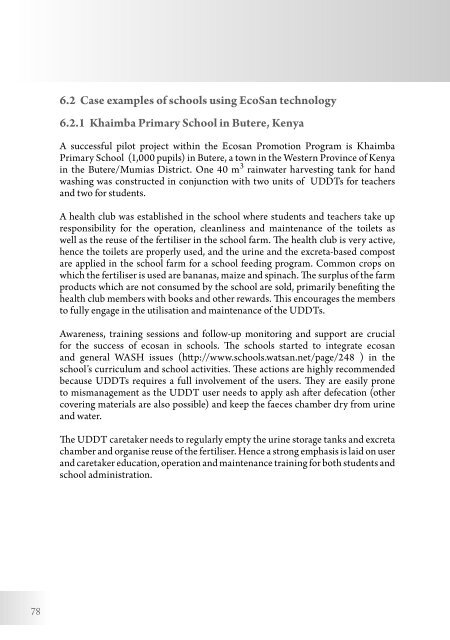Technical Guide to EcoSan Promotion
Technical Guide to EcoSan Promotion
Technical Guide to EcoSan Promotion
Create successful ePaper yourself
Turn your PDF publications into a flip-book with our unique Google optimized e-Paper software.
6.2 Case examples of schools using <strong>EcoSan</strong> technology<br />
6.2.1 Khaimba Primary School in Butere, Kenya<br />
A successful pilot project within the Ecosan <strong>Promotion</strong> Program is Khaimba<br />
Primary School (1,000 pupils) in Butere, a <strong>to</strong>wn in the Western Province of Kenya<br />
in the Butere/Mumias District. One 40 m 3 rainwater harvesting tank for hand<br />
washing was constructed in conjunction with two units of UDDTs for teachers<br />
and two for students.<br />
A health club was established in the school where students and teachers take up<br />
responsibility for the operation, cleanliness and maintenance of the <strong>to</strong>ilets as<br />
well as the reuse of the fertiliser in the school farm. The health club is very active,<br />
hence the <strong>to</strong>ilets are properly used, and the urine and the excreta-based compost<br />
are applied in the school farm for a school feeding program. Common crops on<br />
which the fertiliser is used are bananas, maize and spinach. The surplus of the farm<br />
products which are not consumed by the school are sold, primarily benefiting the<br />
health club members with books and other rewards. This encourages the members<br />
<strong>to</strong> fully engage in the utilisation and maintenance of the UDDTs.<br />
Awareness, training sessions and follow-up moni<strong>to</strong>ring and support are crucial<br />
for the success of ecosan in schools. The schools started <strong>to</strong> integrate ecosan<br />
and general WASH issues (http://www.schools.watsan.net/page/248 ) in the<br />
school’s curriculum and school activities. These actions are highly recommended<br />
because UDDTs requires a full involvement of the users. They are easily prone<br />
<strong>to</strong> mismanagement as the UDDT user needs <strong>to</strong> apply ash after defecation (other<br />
covering materials are also possible) and keep the faeces chamber dry from urine<br />
and water.<br />
The UDDT caretaker needs <strong>to</strong> regularly empty the urine s<strong>to</strong>rage tanks and excreta<br />
chamber and organise reuse of the fertiliser. Hence a strong emphasis is laid on user<br />
and caretaker education, operation and maintenance training for both students and<br />
school administration.<br />
78

















